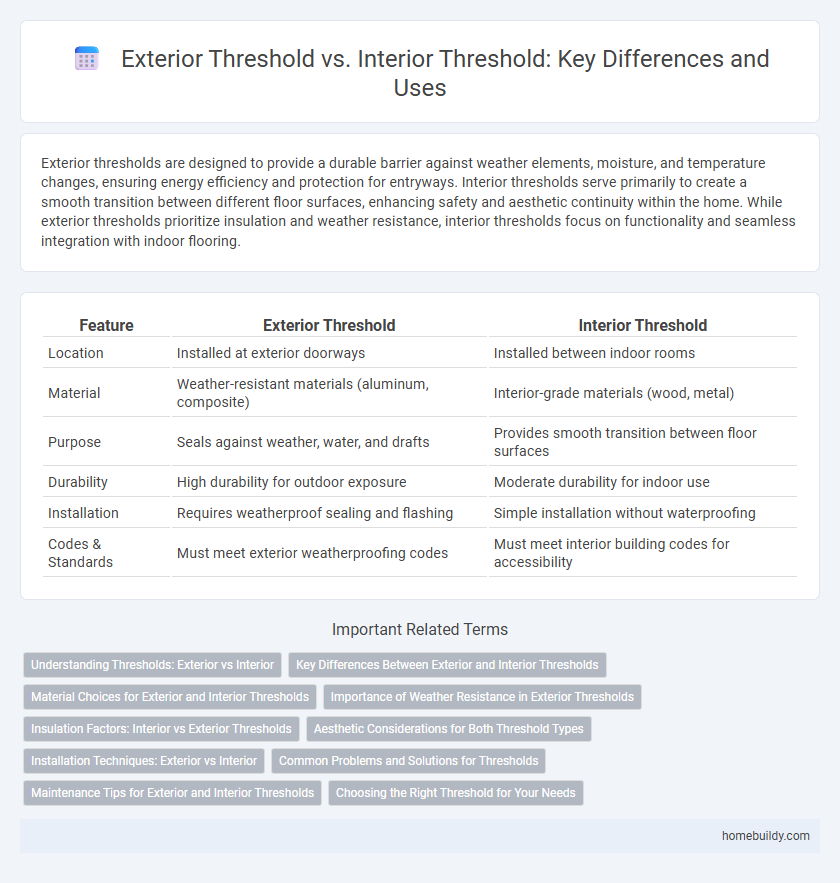Exterior thresholds are designed to provide a durable barrier against weather elements, moisture, and temperature changes, ensuring energy efficiency and protection for entryways. Interior thresholds serve primarily to create a smooth transition between different floor surfaces, enhancing safety and aesthetic continuity within the home. While exterior thresholds prioritize insulation and weather resistance, interior thresholds focus on functionality and seamless integration with indoor flooring.
Table of Comparison
| Feature | Exterior Threshold | Interior Threshold |
|---|---|---|
| Location | Installed at exterior doorways | Installed between indoor rooms |
| Material | Weather-resistant materials (aluminum, composite) | Interior-grade materials (wood, metal) |
| Purpose | Seals against weather, water, and drafts | Provides smooth transition between floor surfaces |
| Durability | High durability for outdoor exposure | Moderate durability for indoor use |
| Installation | Requires weatherproof sealing and flashing | Simple installation without waterproofing |
| Codes & Standards | Must meet exterior weatherproofing codes | Must meet interior building codes for accessibility |
Understanding Thresholds: Exterior vs Interior
Exterior thresholds are designed to withstand weather elements, featuring durable materials like aluminum, fibreglass, or hardwood to provide a secure barrier against water, air, and temperature fluctuations. Interior thresholds are primarily used to create smooth transitions between different flooring types while accommodating height differences and enhancing sound insulation within the home. Both types play crucial roles in maintaining structural integrity and comfort but serve distinct functional and environmental purposes.
Key Differences Between Exterior and Interior Thresholds
Exterior thresholds are designed to provide weather resistance, durability, and thermal insulation to prevent drafts and moisture infiltration, typically made from materials like aluminum, vinyl, or composite. Interior thresholds focus on smooth transitions between different flooring types and soundproofing, usually crafted from wood or MDF without the need for heavy-duty weather sealing. Key differences include the material strength, weather resistance, and insulation properties tailored to exterior versus interior environmental demands.
Material Choices for Exterior and Interior Thresholds
Exterior thresholds typically utilize durable materials such as aluminum, stainless steel, and composite woods designed to resist moisture, temperature fluctuations, and heavy foot traffic. Interior thresholds often feature softer materials like hardwood, vinyl, or MDF that provide a smooth transition between rooms while complementing indoor aesthetics. Choosing the right material balances durability, weather resistance for exterior use, and visual appeal for interior applications.
Importance of Weather Resistance in Exterior Thresholds
Exterior thresholds require superior weather resistance to prevent water infiltration, thermal loss, and damage from environmental elements such as rain, snow, and UV exposure. Made from durable materials like aluminum or stainless steel, these thresholds ensure longevity and maintain the structural integrity of entryways. Interior thresholds prioritize aesthetic transitions between rooms and soundproofing but do not require the same level of weatherproofing.
Insulation Factors: Interior vs Exterior Thresholds
Exterior thresholds require superior insulation materials such as foam gaskets and weatherstripping to prevent heat loss and moisture intrusion, enhancing energy efficiency and indoor comfort. Interior thresholds, while less exposed to harsh weather, benefit from insulation that minimizes air leakage between rooms and maintains consistent indoor temperatures. Proper insulation selection for both threshold types significantly improves thermal performance and reduces energy costs.
Aesthetic Considerations for Both Threshold Types
Exterior thresholds often prioritize durable materials like aluminum or stone to withstand weathering while offering sleek, modern aesthetic finishes that complement the building facade. Interior thresholds focus on seamless transitions between rooms, utilizing wood or vinyl with subtle color and texture variations to enhance interior design continuity. Both types require careful attention to detail to balance functionality with visual appeal, aligning threshold style with overall architectural themes.
Installation Techniques: Exterior vs Interior
Exterior threshold installation requires durable weatherproof materials like aluminum or composite to withstand moisture, temperature fluctuations, and heavy foot traffic, ensuring a tight seal against drafts and water infiltration. Interior threshold installation focuses on smooth transitions between flooring types, using materials such as wood or metal that complement indoor aesthetics while allowing for expansion and contraction of adjacent floors. Proper anchoring and sealing techniques differ, with exterior thresholds demanding robust caulking and flashing to prevent water damage, whereas interior thresholds emphasize precise leveling and secure fastening to avoid tripping hazards.
Common Problems and Solutions for Thresholds
Exterior thresholds commonly face issues such as water infiltration, warping, and damage from weather exposure, which can lead to drafts and energy loss; solutions include installing weatherstripping, using durable materials like aluminum or composite, and ensuring proper sealing. Interior thresholds often experience wear from foot traffic, misalignment, and squeaking, which can cause tripping hazards and reduce door functionality; addressing these problems involves regular maintenance, adjusting hinges, and replacing worn threshold strips. Both types benefit from correct installation and routine inspection to prevent long-term damage and maintain efficient door operation.
Maintenance Tips for Exterior and Interior Thresholds
Exterior thresholds require regular cleaning to remove dirt, debris, and moisture that can cause rust or rot, and applying weather-resistant sealant helps preserve materials like wood or metal. Interior thresholds benefit from routine vacuuming to clear dust and prevent abrasive buildup, while inspecting for cracks or warping ensures a tight, energy-efficient seal. Using appropriate lubricants on moving parts of both exterior and interior thresholds enhances functionality and extends lifespan.
Choosing the Right Threshold for Your Needs
Exterior thresholds are designed to withstand weather elements with durable, weather-resistant materials such as aluminum, stainless steel, or composite, ensuring effective sealing against moisture, drafts, and temperature fluctuations. Interior thresholds prioritize smooth transitions between rooms, often made from wood or vinyl, optimizing comfort and reducing tripping hazards. Selecting the right threshold depends on factors like location durability requirements, insulation needs, and aesthetic preferences to enhance energy efficiency and door performance.
Exterior Threshold vs Interior Threshold Infographic

 homebuildy.com
homebuildy.com